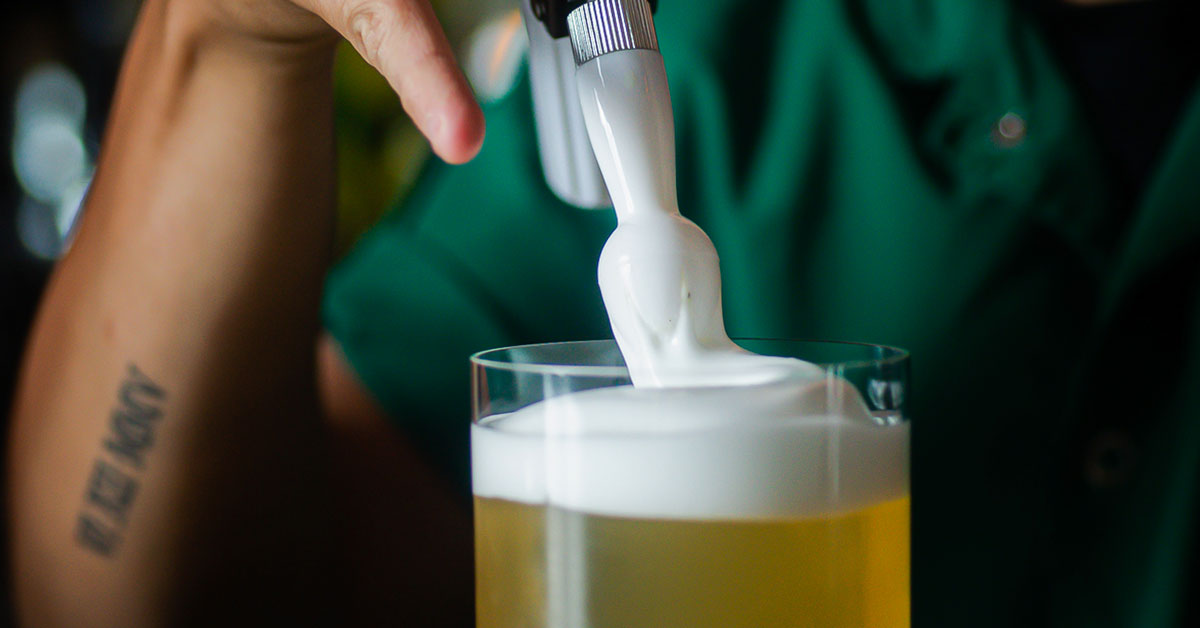
In Episode 6 of Netflix’s Drink Masters, the judges task the contestants with creating an Irish whiskey Old-Fashioned with orange-flavored “air.” In cocktail parlance, the air in question refers to flavored liquid that’s been aerated into a foam to be dolloped atop the finished drink. On the show, the technique appears not just in this specific challenge, but over and over again. It might be easy to dismiss the frothy cameos as little more than telegenic flourishes, but even in the real world, foam—once a staple in avant-garde culinary and cocktail circles—has been staging a comeback in high-concept cocktail bars everywhere.
Kate Gerwin, a Drink Masters finalist and owner of Happy Accidents in Albuquerque, New Mexico, was already a fan of foams long before she appeared on the show. One of her bar’s signature cocktails, the Happy Little Accidents, has a split base of tequila and Venezuelan rum alongside guava and salted Chinese plum, topped with passion fruit foam. “Foam provides the designer of the cocktail a way to highlight an ingredient without making it super strong,” says Gerwin. “It provides a lot to the cocktail texturally that you can’t get out of shaking the ever-living crap out of a drink.”
Of course, the use of foams in cocktails is hardly new. The practice can be traced back to the rise of molecular gastronomy in the early aughts, coinciding with a new wave of European chefs, like Ferran Adrià of El Bulli, who were experimenting with techniques to coax new textures and flavors from food. “You had the cocktail renaissance happen in the U.S. and Europe around the same time that the Spanish culinary invasion was happening in the early 2000s,” says Dave Arnold, whose trailblazing cocktail bars Booker and Dax and Existing Conditions took a more scientific approach to cocktail design. “The iSi canister went from being used primarily as a whipped cream maker to something that was being used by chefs to make stand-alone flavored foams.” As these molecular techniques spread virally throughout the culinary world, foam inevitably began popping up in progressive bars, too.
But the foam fad didn’t last long. Many bartenders soon soured on the technique, to avoid being perceived as parroting the ideas of experimental chefs. “Because foams were labeled as being a part of that Spanish culinary invasion, it became passé because many of us didn’t want to be seen as just copying whatever was happening in Spain,” says Arnold. “That’s one of the reasons I never really used them.”
Peek at the menus of top cocktail bars across the globe, however, and it quickly becomes clear that foam is back on top. At Drastic Measures, a James Beard Award semifinalist for Outstanding Bar in Shawnee, Kansas, the Gimme Gimme ’Smore tops a base of graham cracker fat-washed rum and coconut water cold brew with a “reconstructed” marshmallow foam. At Lullaby in New York City, the Bohemian Rhapsody combines gin, white grapefruit and a dash of Chartreuse, crowned with an elderflower-rhubarb foam. At some bars, foam is even bubbling up beyond the cocktail glass. At Bar Kaiju in Miami, spiced corn foam is dispensed directly from an iSi canister onto the back of guests’ hands as a “bump.” At Paradiso in Barcelona, meanwhile, a smoky mezcal and hibiscus cocktail called The Cloud is served with a poufy coffee-flavored, well, cloud that hovers over the glass like an impending rainstorm.
Decades after its cocktail world debut and subsequent abandonment, foam is very much back, in part as a way to offer guests new experiences. Dante Colombo and his bar team at John Brown’s Underground in Lawrence, Kansas, found themselves embracing foams and airs to shake off the dust from making so many to-go cocktails during the height of the pandemic. “Visually and texturally, to-go drinks don’t give you a whole lot of options of how a drink can look and feel,” says Colombo. “Foams and airs became a way for us to add elements that are visually interesting and to incorporate ingredients in new ways.”
Foam’s resurgence may also be fueled in part by the breadth of new tools and techniques that bartenders have developed to aerate liquids. Aside from the popular iSi canisters, bartenders also employ milk frothers, siphons, air pumps and powdered additives like Foam Magic to fluff up texture. For the Adult Braces, a New York Sour riff at John Brown’s Underground, Colombo makes a red wine air by MacGyver-ing a fish tank bubbler with an aeration stone (purchased at a local pet store) to create the featheriest texture possible. The wine-flavored air acts as a stunt double for the classic red wine float, seemingly levitating inside the highball glass.
For his part, Arnold thinks enough time has passed that certain molecular flourishes don’t carry the baggage they once did. “The first generation of people who were interested in this kind of stuff, we’re old now,” he says, “I don’t think there’s any stigma to using any of these techniques for young bartenders.”
Indeed, for a generation of bartenders accustomed to moonlighting as content creators, foams have become a useful tool for amplifying the visual appeal of their cocktails in digital spaces. Alexia Quagliotti, a Rome-based cocktail consultant known to her 10,000-plus Instagram followers as @aladybehindthebar, notes that presentation is increasingly important, transforming cocktail design into a fashion statement. “It’s no longer mixology,” she says. “It’s haute couture drinkology.”
